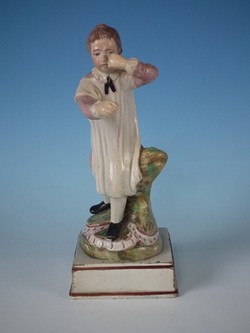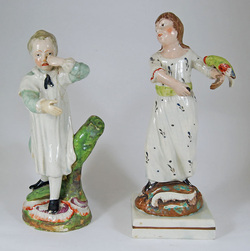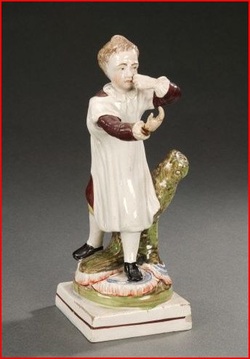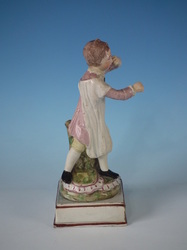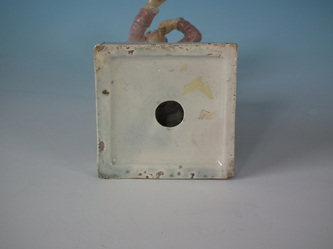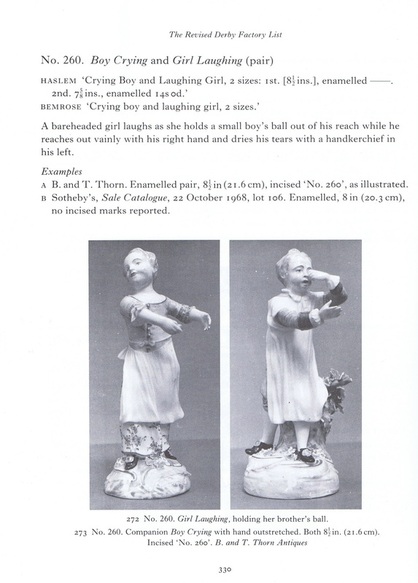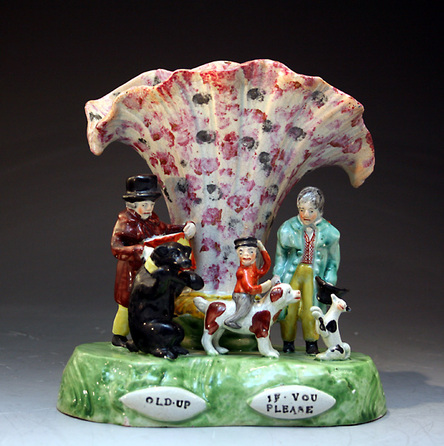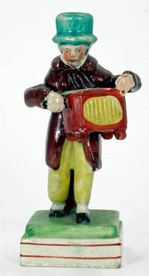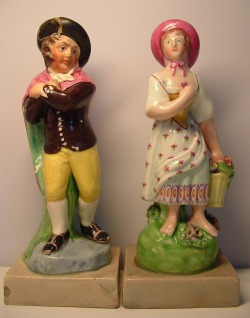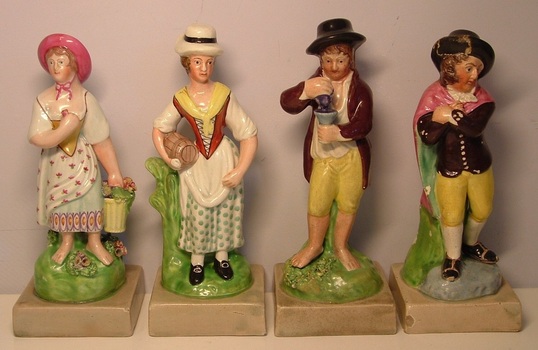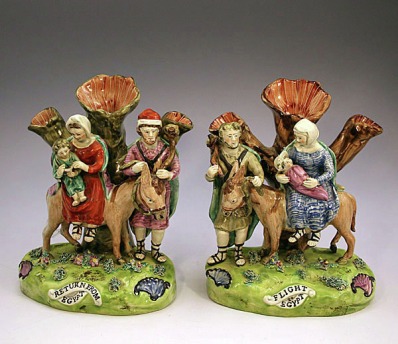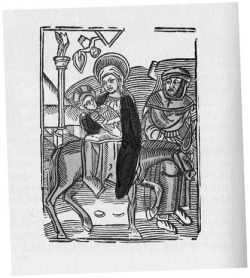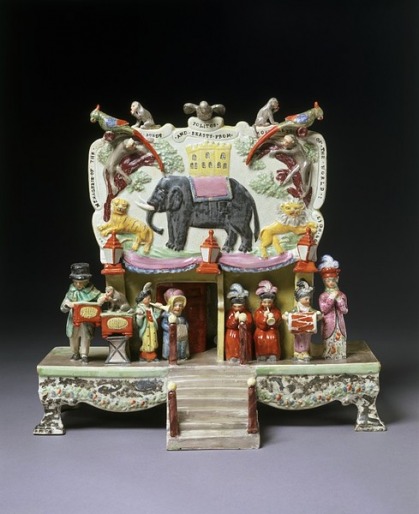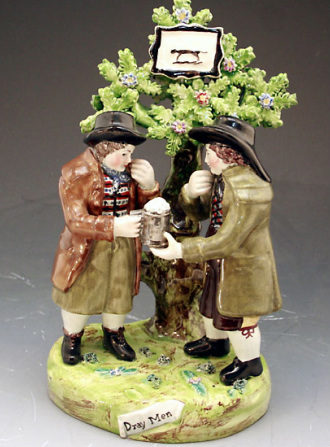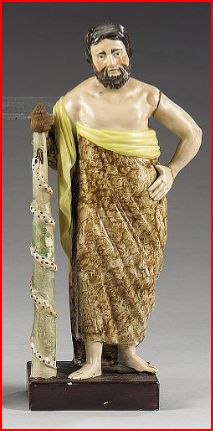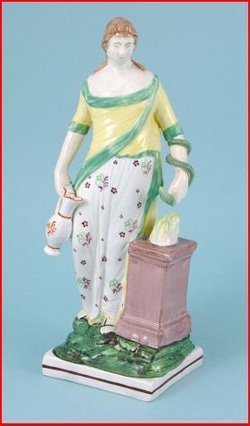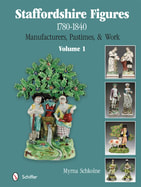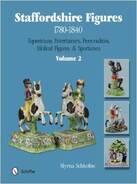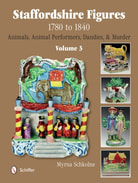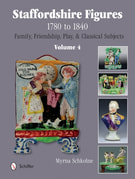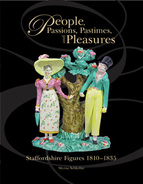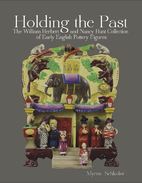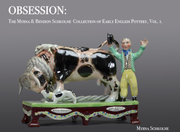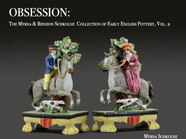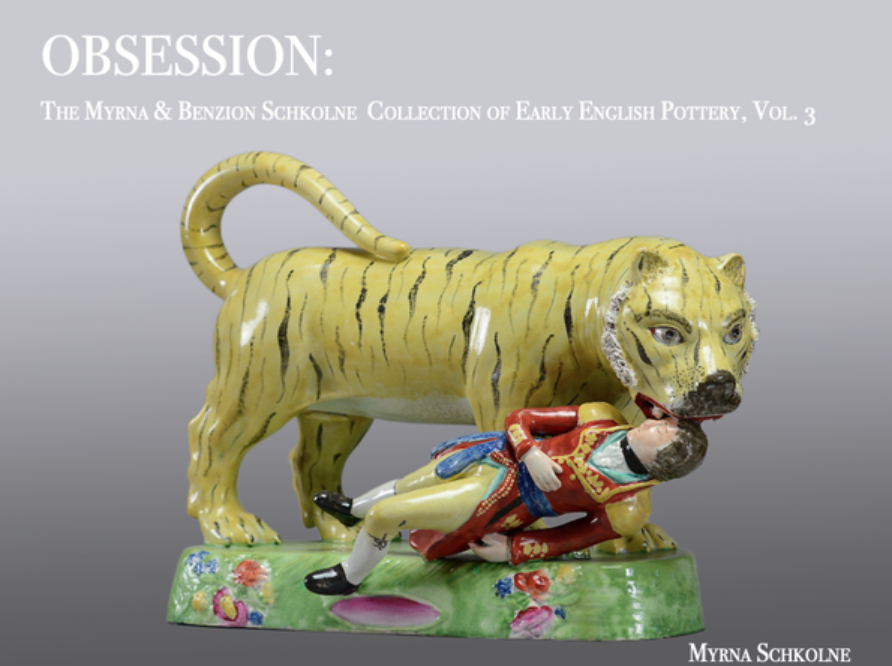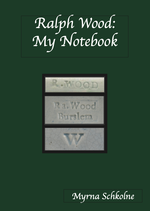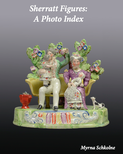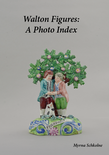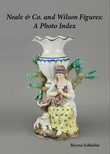Many thanks to Andrew for sharing his vast knowledge.
|
An unusual figure in the stock of Madelena Antiques caught my eye. The description reads "Book reference not found"--and I can't find the figure in a book either. I had never seen this figure until I visited Brighton Museum's Willett Collection last year. There I found an example in the reserve collection--along with another figure that the Keeper, Stella Beddoe, pointed out as its pair. In my photo archive I have just one other example of this figure. This little boy went through auction a while ago. As you can see, this base has a single painted line, just like the base on the girl in the Willett Collection. Enoch Wood used this base decoration, as did very many other potters. But the high base with two painted lines on Madelena's figure appears to occur only on Enoch Wood's figures, so I would attribute the figure to the Enoch Wood manufactory with reasonable confidence--nothing except death and taxes is 100% certain. Madelena's figure is a lovely glimpse of the past. And figures of children playing would make a fascinating collecting theme. UPDATE Andrew Dando points out that these figures are after Derby models referred to in Peter Bradshaw's Derby Porcelain Figures 1750-1848, page 330, as Crying Boy and Girl Laughing. The girl holds a ball in her hand and taunts the boy, who cries as he reaches for it. Our pottery girl in the Willett Collection also hold a ball in her hand, but there is a colorful bird perched on her other hand. As best I can tell from looking at my high res digital image, that bird is original. Some potter just hated an arm stretched out into nothingness....but then pottery is so much nicer than porcelain!
Many thanks to Andrew for sharing his vast knowledge.
0 Comments
You simply cannot have too many pairs of dandies. Charming dandy and dandizette couples, looking as if they have just stepped from their century into ours, are quintessentially Staffordshire. For that reason, I put a stunning pair of dandies on the dustjacket of my book. The Reed Fitt Collection, auctioned in the UK in February 2000, comprised at least 25 pairs of dandies in all shapes and sizes. Miss Cyllene Reed and her companion Miss Beatrice Fitt were passionate collectors by not long after World War II. In the next 50 years, the ladies amassed a remarkable collection. Clustered together on the back of the catalog cover, the figures appear in a tree-filled world of their own. And on an inner page, dandy couples snake in a long curving row, as if they were queuing. I have a pair of dandies from the Fitt Reed sale, and several other pairs besides. The most ordinary form can be extraordinarily wonderful. If you tire of dandies you have tired of life. Pairs with the dandy and dandizette on individual bases are quite uncommon. Fellow collectors whom I met in the UK this month kindly shared photographs of the pair below. Aren't they fabulous? These rare gems have been dubbed "Sam and Josh" by their owners. I call dandies of this form "skinny dandies", because of their narrowness . I have noted a similar pair in a Christies catalog. And then there is a pair in my book. Yes, the pair in my book are unconventional in that both are male--but perhaps Staffordshire potters were ahead of their times in acknowledging what is today quite acceptable.
I have spent the last ten days traveling. Yes, again! This time, I went to the UK to chase down a host of Staffordshire issues. My trip was filled with wonderful moments that included discovering figures I have not seen before (and you will be seeing them here at some point), meeting new collectors, seeing new collections, and, above all, catching up with collector and dealer friends. Last Thursday, I went to the antiques show at the NEC. The first two hours were almost intoxicating as people thronged through the door and charged to make purchases. The large hall got quite hot. The show is not as big as it used to be and, sadly, there were not as many dealers selling figures. Philip Carrol was there--or at least his lovely stock was. I tried to catch up with him twice but missed him each time. Roger De Ville, as always, had a lovely small selection and he had a good day. Another dealer who must have had a good day was John Howard. No surprise here because John stocks the very best, and that is just what collectors want. Figures vanished quite quickly from John's stand--including the lovely dray men group I posted recently-- and I returned home to several emails from happy buyers. John has a fabulous performing animal troupe, very much in the "Sherratt" style. You can see one like it--but with major restorations--in my book. I included it in the book, despite the made-up dog and monkey, among other things, because it is such a rare treasure. John's is simply dazzling. The enamels are spiffy and all the figures are original, with just the tiniest restorations. It is as fine an example as you will ever see. Why didn't I buy it? Well, I own two performing animal troupes already (see November blog here), so this has to go to another home. I did buy one little figure in the UK. (Poor picture and the figure is dirty....needs a bath.) But, as you can see, this man with a barrel organ is formed from the same molds as used for the figure in John's troupe. You also find him on large "Sherratt" menageries. I was pleased with my purchase. I now have several little "Sherratt" musicians...more on that another time. As you know, I love little figures. They really display fantastically among bigger stuff.
I spent a day visiting Andrew and Jan Dando in Bradford-on-Avon. The shop was charming and I was struck by the quality of the stock. I know Andrew takes fabulous pictures, but the stock was even nicer in real life. Andrew clearly has a great eye. I even found myself admiring some of the early porcelain figures, but fear not! I shall never be a porcelain collector. Am I in a hurry to go back?. Not after my ten-plus hour wait for a connection in Washington. I got home at 4:00 a.m. and don't intend hauling out a suitcase for a long, long time. In my blog posting of March 2010, I discussed a family of figures on gray rectangular bases. These figures are not plentiful, but when you see one it 'pops' because of the really great enamels. Then on April 8, 2010, I wrote "Our family of figures with gray bases is growing. I doubt you will recall the blog article of March, but we featured a figure of Spring among the small group of gray-based figures. Spring now has a companion: Winter. The bases are formed identically and their size is the same. The collector who owns these pieces hopes one day to have the complete set...so shout if you see any more!" Well, it has happened, and in less than a year. The set is complete, which just shows what can be done with a little diligence and determination. You may think that the figure representing Summer is not as it should be, but that is debatable. Usually Summer is represented holding a wheat sheaf. In this case, she holds a barrel of ale. The figures of Summer and Autumn (man with grapes) were bought as a pair. A mismatched pair, you ask? I am not so sure. The only other time I have seen either of these figures they too were paired thus. 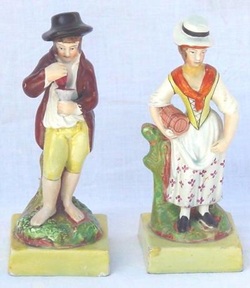 Here we have have Autumn paired with the lady with the barrel yet again. I am thinking that this was the intended pairing from this potbank. You could probably buy the figures as singles, and perhaps the lady with the barrel was the nearest thing to Summer...so it stood in for Summer. Who knows? Yes, the gray base sometimes is rather yellow, as you see here! The more I learn, the less I know. For the record, the lady with the ale barrel was made by a number of pot banks. Ralph Wood made the figure, and I have an example with ALE on the barrel. This Ralph Wood figure is sometimes found titled HAY MAKER. It seems to pair with a man with a scythe, titled MOWER. Other pot banks made this pairing too. But in the case of our Gray Base pot bank, we have not yet found a mower, nor have we found any other viable candidate for Summer. The jury is still out, but for now at least, I think the set of Four Seasons featured in this posting is complete. Is it not terrific???
When John Howard posted a pair of marked WALTON spill vases on his site some months ago, my antennae sensed the vibe. Others too picked up on this earthshaking event. A friend emailed "What do you think of John Howard's Flight & Return?" I answered "FABULOUS'. He replied "Just surfing not buying. When it is price group E, it is of academic interest only." Clearly, few of us can afford to buy at the top end of a dealers' stock consistently or if at all. But price group E (John's top group) should not be considered like the number 13--off limits. Admittedly, E is for Extravagant, Exorbitant, and Excessive. But it is also the letter for that mirage all collectors pursue: Excellence. And Excellence is Elusive! As far as examples of Flight and Return go, John's pair took my breath away. The light danced around the glaze on the interior of the spills, the enamels were rich, and I knew these figures had an impressive footprint. I have seen but one other pair of WALTON Flight and Return spills. They reside in the Reserve Collection of The Potteries Museum in Stoke-on-Trent and are definitely Not For Sale! The figures have since sold. I didn't buy them because I was recovering from sending John a chunk of money. Yes, I love finding great figures inexpensively but I do put my money where my mouth is and buy the best when I can. I might just buy from Osama Bin Laden if he had what I wanted. The difference is that with John it is always a pleasure. Although almost two centuries old, these figures are a very true pair. Clearly, they have lived together always. Look at the identical match of the decorative detailing The Flight and Return have been depicted as mirror images in art for centuries. The Return appears on the 8thC Ruthwell Cross and both appear in the 12thC St. Alban's Psalter. By the 19thC, they were common in art and even occurred in cheap wood cuts, such as the one below. When I was in London a while ago, I found the pair colorfully depicted in a pair of early 19thC cottage prints published by P&P Gully. Happily, they now reside with a collector who has a pair of similar figures. Were these prints the actual design source for his figures? It is nice to think so.
Seems this happened at least 20 years ago, but my computer files tell me it was as recent as Spring 2002. I had a serious case of the collecting bug...yet I had never seen a Staffordshire menagerie. Yes, I had seen pictures in books, but never in the flesh, so to speak. My auction experience was limited--zero would be closer to the truth--because in those days auctions were not yet on the Internet. And then I discovered that Waddingtons in Toronto had a Polito's menagerie coming up. Waddingtons--I now know this to be one of the very few 5-star auction houses for ceramics--sent me a condition report. The menagerie was remarkably intact. Clearly, it was going to be a major purchase and, as I had no idea of what I might be buying, I decided to buy a plane ticket and go and see for myself. I arrived in Toronto late afternoon, checked into a cheap hotel, and walked over to Waddingtons. Bill Kime, the ceramics specialist, could not have been more courteous and patient. The menagerie was impressive....but it didn't make my heart sing. It could not be faulted, but I didn't want to own it. It had the structural perfection I sought, but the enamels were not wonderful and the colors were wan. It was clunky. Nothing redolent of fairgrounds in days gone by. Was this as good as menageries got? Should I consider bidding at a low level? Was there something wrong with me, or with the menagerie? Confusion ruled my brain that night. The auction was the next day at around noon, and the menagerie came up early. All my worries about whether to bid evaporated fast. I didn't even get to raise my hand as the bidding quickly soared to, as best I recall, a final price of over $40,000 (USD). FYI, the menagerie had been bought at Grosvenor House from Alistair Sampson for 500GBP in the early 1970s.
So was my trip a waste of time and money? I was empty handed but 'full-headed". I had learned SO much. You have to know what you don't want before you can really know what you do want. When the right menagerie came my way later, I knew it in a heartbeat. By then, I had seen several menageries. None had pushed my button, but each had pushed me along the learning curve. Also, my trip taught me to trust and respect Bill Kime's judgment, and that proved valuable later on...and will again, I am sure. Other experiences:
In the past days, I have had lots of chatter from collectors about an impressive figure group in John Howard's stock. Lovely, is it not? And almost as rare as hens' teeth. I know of two other examples. One is pictured in my book People, Passions, Pastimes, and Pleasures: Staffordshire Figures 1810-1835. The draymen are identical to John's example, except each wears the other's waistcoat. Yes, that gorgeous lustre tankard is present, but the bocage was formed somewhat differently, and there is no inn sign. (I have checked, the group was not damaged but was made that way) 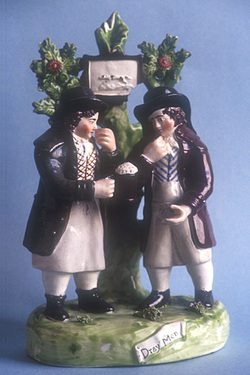 The only other example I know of is in the Willett Collection, Brighton Museum. This is my all-time favorite collection, but this dray men example falls short. Very wooden, isn't it? And something funny is happening above the inn sign, I think. And look at that lower hand on the right, grasping air. Hmm..... 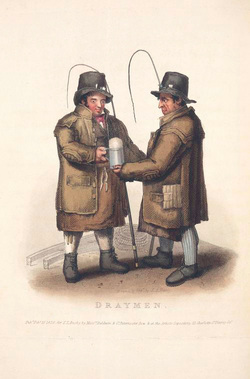 I found this print in the NY Public Library. It is from Thomas Lord Busby's Costume of the Lower Orders of London, published in 1820. Surely it is the design source for John's dray men group? For those, who like me once-upon-a-time, do not know what a drayman is, let me share my enlightenment. A dray is a flat cart, without sides, generally pulled by horses or mules, and ideal for transporting large barrels of beer from breweries to pubs. The men who operated drays were called draymen. They were a breed apart, so read all about them in my book. And, if you are quick, you can buy the figure from John.
PS: I erred. I do know of more than three examples of this figure group. I have two examples on record that are rather unattractive, probably quite restored. And Jonathan Horne's final exhibition featured a rather attractive example. Do you know who this figure represents? Know who he is? The snake-entwined staff in this kindly classical gentleman's right hand is the clue. He is Aesculapius, the ancient god of medicine. His staff with it’s single snake is the correct traditional symbol of medicine, our use of a twin-snaked caduceus being a confused 20th century adoption. Aesculapius is not a particularly common figure, but it is one I would like to own. My modern-day doctor is slightly better dressed, but I wish he exuded the same patience that Aesculapius does. How times have changed! I know of only two potbanks that made Aesculapius. His female counterpart, on the other hand, seems to have been a far more popular subject. She is Hygiea the goddess of health. Hygiea was Aesculapius's daughter and she miraculously healed by administering the bile of the gorgon Medusa. For this reason, Hygiea is portrayed with an ewer and bowl holding Medusa’s bile. In ancient statuary, Hygeia frequently feeds a snake from a bowl, the snake symbolizing healing or rebirth because of its ability to shed its skin.
So aren't classical figures fascinating? If you want Aesculapius, you will have to be patient. Hygiea is easy to find, particularly if you tolerate a mediocre example. But a beauty, like the one shown here, requires a little more patience and is well worth the wait. |
Archives
February 2024
All material on this website is protected by copyright law. You may link to this site from your site, but please contact Myrna if you wish to reproduce any of this material elsewhere. |
